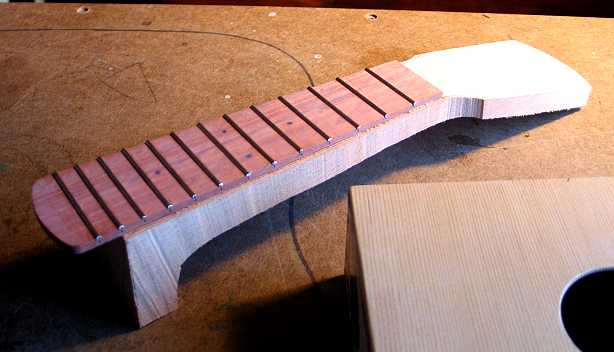For this uke, I bought a 3" by 3" mahogany blank (good for two necks). I bandsawed this one-piece neck blank.

Here I have glued the fingerboard to the neck blank. Oh, yeah --- I forgot to mention that the fingerboard is about 1/8" thick.
For this uke, I bought a 3" by 3" mahogany blank (good for two necks). I bandsawed this one-piece neck blank. |
Here I have glued the fingerboard to the neck blank. Oh, yeah --- I forgot to mention that the fingerboard is about 1/8" thick. |
|
After carving the neck, I drilled a 5/16" hole about 1/2" deep into the middle of the heel, for the threaded insert. I measured the same distance down from the top of the box, and drilled a 5/16" hole into and through the neck block.
Here is the insert (you use an allen wrench to screw it in), which accepts the 1/4"-20 bolt. Both are readily available at Ace Hardware stores. |
I forgot to take photos of the making of the bridge. The bridge is about 1/8" thick. I used my Stew-Mac saddle slotting jig to rout out the slot for the 1/8" saddle. The center of the saddle falls at 13.58" from the nut (longer than the 13.5" scale length, for compensation). I located the bridge position, drilled four 1/16" holes about 5/8" behind the middle of the saddle, all the way through the bridge and bridge patch, for the strings to pass through. Then, using two of the drill pins as locators, I glued the bridge onto the top, using C-clamps with the back lid opened. (This is what is neat about these cigar box ukes --- you can so easily access the innards!!!) After the bridge was set, I removed the neck from the body. I then spent about five days wiping on the Tru-Oil finish. I wiped on a coat in the morning before I went to work, another coat after I got home from work, and one coat right before going to bed that night. Between each coat, I lightly scuffed the surface with some 0000 steel wool. I installed the Gotoh tuners (some nice amber ones this time), made the 1/8" thick nut and saddle, strung it up with Aquila Nyl-gut strings, and did the set up. |
|